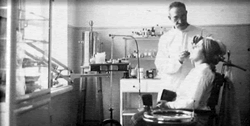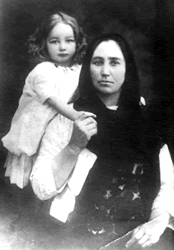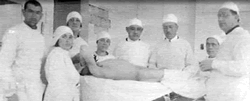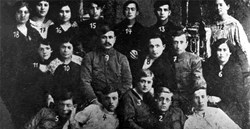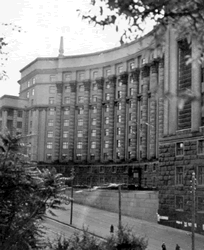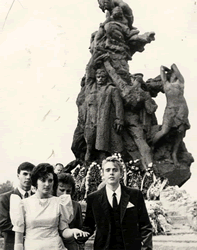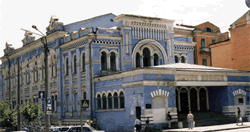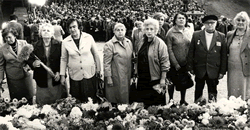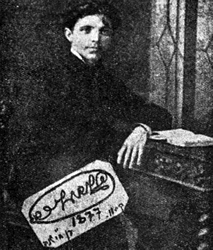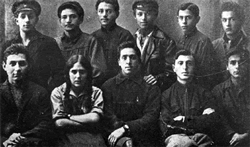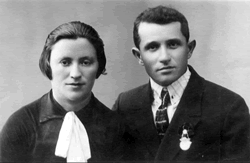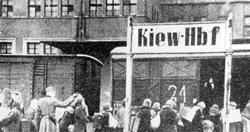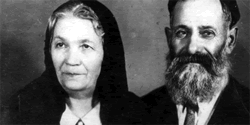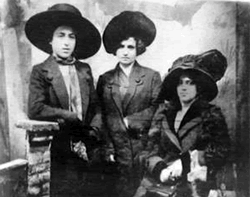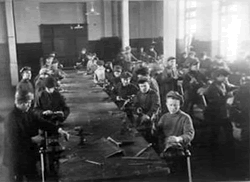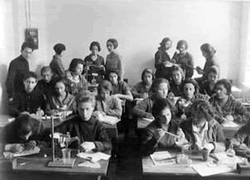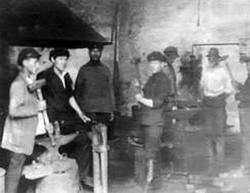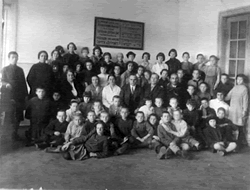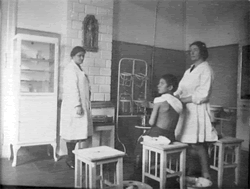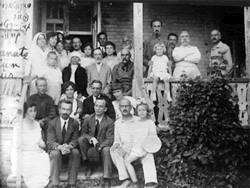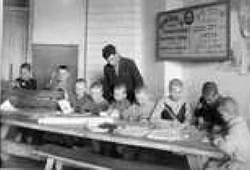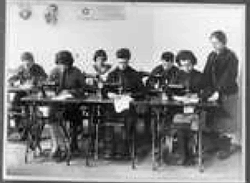|
#kiev-1: at the dentist office at a Podolia Polyclinic, run by the Kiev Society for Relief to the Needy 1920s |
#kiev-2: Nekhama Rubezhevskaya was born in Chernobyl, Ukraine in 1871. She was a housewife. Prior to WWII she lived in Kiev, \ |
#kiev-3: Kiev 1920s the operating room at the Surgical Hospital, run by the Kiev Society for Relief to the Needy |
|
#kiev-4: A group of members of the He - Chaluts movement in the town of Ruzhin in the Kiev district. |
#kiev-5: The Soviet house in Kiev during world war 2 |
#kiev-6: Young couples from Kiev on their wedding day near the memorial monument at Babi Yar, Kiev |
#kiev-7: A synagogue in Kiev (Kiyev) |
#kiev-8: Participants at the unveiling of the memorial monument at Babi Yar, Kiev |
#kiev-9: The author Shalom Aleichem, photographed in Kiev (Kiyev) in 1877. |
#kiev-10: A victory procession through liberated Kiev (Kiyev) in the spring of 1944. In the photo: a plaza with a statue of Ukrainian national hero Bogdan Chmielnick |
#kiev-11: Members of the leadership of the Ha - Shomer ha - Tsa'ir youth movement in Kiev (Kiyev) in 1923. |
#kiev-12: Golda and Yoyna Shostak. \. Prior to WWII she lived in Kiev, Golda was murdered in the Shoah Babi Yar eYoinyna was killed as soldier for the Red Army This information is based on a Page of Testimony (displayed here) submitted by her niece, Lidiya Tyutyunik Polyak Gold |
#kiev-13: Forced laborers from the Ukraine getting on freight trains in a railway station in Kiev (Kiyev).during the holocaust |
#kiev-14: Kiev is the birthplace of the world’s first branch of Jewish Scouting, known as Hashomer Hatzair. |
#kiev-15: Zeilik Maryanovski was born in Zlatopol, Ukraine in 1870. He was marriedfir Zeilik and his wife were murdered in the Shoah |
#kiev-16: Studio portrait of three unidentified young women wearing coats and hats: (Jewish Daily Forward English caption:) "When clothes made the woman -- three girl students..." (Yiddish caption) "When girls liked to look like women.... 20 years ago." ca. 1905 |
#kiev-17: "Jewish youths being trained in a machine shop" (Russian inscription): young men and women (at the end of the benches, wearing kerchiefs) working with hammers and files at vises. 1920's
|
#kiev-18: Portrait in a material-science laboratory in a Jewish Progressive School: students analyzing materials, some working with pieces of cloth (front left), at lab tables equipped with magnifying loops, glass beakers, test tubes, alcohol lamps, tripods, etc. 1920's
|
#kiev-19: Portrait in the smithy at the Ratmansky [Trade] School-Factory: five students (holding hammers) working metal at anvils, two older men stand by the work stations. (Back left, a forge, far wall, power switchers.) 1920's
|
#kiev-20: 1926 Kiev staff and children of a Jewish children's home, "recently visited by M. Siganievitsh, a representative of the Argentinian Jews..." (in Yiddish on frame). (Russian/Yiddish sign: "...home maintained by Detroit Federation of Ukrainian Jews.") |
#kiev-21: In the surgical room of the Polyclinic at 4 Kuznetchnaya Street, run by the Kiev Society for Relief to the Needy Ill: two staff members (women in lab coats), one attends to a boy's arm. (A tiled stove with the relief of a knight on far wall.) 1928
|
#kiev-22: Group portrait on a wooden porch at a "sanatorium for educated people" (Yiddish and German inscriptions): (French registration form on back:) "Client: the Executive Committee, address: Jewish, entered: 19th, for: 21st, ...zinc, copper, -Observations -." 1920's
|
#kiev-23: Portrait of a bookbinding workshop at the Jewish children's [day] home at 26 Kuzniets Street: children working at different steps of the bookbinding process. (Russian/Yiddish sign: "...home is maintained by the United Jewish Aid Society of Canada.") April 1924
|
#kiev-24: Portrait of a sewing class at a Jewish Progressive School: six young men and women each working at a Singer sewing machine; an instructor (r). (Portraits of unidentified men and a Russian banner with red star reading "...Cheaper Merchandise" on wall.)
|
#kiev-25:
|
#kiev-26: |
#kiev-27: |
#kiev-28: |
#kiev-29: |
#kiev-30: |
#kiev-31: |
#kiev-32: |
#kiev-33: |
#kiev-34: |
#kiev-35: |
#kiev-36: |
Please share your comments or photos or links for posting on our Guestbook Page here: egl.comments@gmail.com
The Jewish Community of Kiev
In Ukrainian: ???? / Kyiv
Capital of Ukraine.
Jewish merchants settled in Kiev, the important commercial crossroads of west Europe and the orient, from the 8th century. Chronicles relate that Jews from Khazaria tried to convert Vladimir, the prince of Kiev (10th century). A letter in Hebrew of the year 930 (found in the Cairo Genizah) approached the Jews of other communities to assist in the release of a Jew from Kiev who had been arrested for a debt.
Both Benjamin of Tudela and Petathiah of Regensburg mention Kiev in the 12th century. Rabbi Moses of Kiev corresponded with Jacob Ben Meir Tam in the west and with the Gaon Samuel Ben Ali in Baghdad. Under Tartar rule (1240-1320) the Jews were protected, earning them the hatred of the Christian population, and with the annexation of Kiev to Lithuania, the Jews were granted privileges ensuring the safety of their lives and property. Some of them leased the collection of taxes. The community grew in size and scholarship. In the 15th century rabbi Moses of Kiev wrote commentaries on the Sefer Yetzirah and on the commentaries of Abraham Ibn Ezra, and held disputations with the Karaites. In the Tartar raid (1482), many Jews were captured and in 1495 the community was expelled to Lithuania.
The community was reestablished when the decree was revoked (1503), but 100 years later the citizens obtained a prohibition from the king of Poland (who had united Kiev and Lithuania in 1569) forbidding Jewish settlement and acquisition of real estate (1619) Kiev. The few who remained were killed in the Chmielnicki massacres (1648-49) and with the annexation of the city to Russia in 1667 the prohibition on Jewish settlement was renewed.
The community was reestablished in 1793 with the second partition of Poland and the conflict with the Christian citizenry resurged. By 1815 there were 1,500 Jews and two synagogues and communal institutions. In 1827 Czar Nicholas I acceded to the citizens' demands and Jewish residence in Kiev was once again forbidden. In 1861 two suburbs were assigned to those Jews permitted to reside in Kiev - merchants, wealthy industrialists, their employees, members of the liberal professions, and craftsmen. Despite the prohibition, hundreds of Jews attended the annual fairs and lodged at two municipal inns - leased by Christians. Within ten years the Jewish population grew to 13,000 (12% of the population).
In May 1881 anti-Semitic pogroms broke out. Many Jews were wounded, Jewish property was damaged, and about 800 families ruined. Until the 1917 Russian revolution, the city became notorious for police "hunt attacks" on illegal Jews. Despite this, the Jewish population grew from 50,000 in 1910 to over 81,000 in 1913, and probably even more evaded the census. Many Jews were employed in factories in and around Kiev. Some were wealthy, such as the sugar industry magnates Brodsky and Zaitsev. Most were engaged in the liberal professions and there were 888 Jewish students in Kiev University in 1911 - the largest concentration of Jewish students in a Russian university. Hebrew writers lived in the city, notably J. Kaminer, J.L. Levin (Yehalel), M. Kamionski. L.J. Weissberg, E. Schulman, and A.A. Friedman. Shalom Aleichem lived in Kiev for a while and described it in his account of "Yehupets". A harsh pogrom hit Kiev on October 18, 1905, but despite the increased impoverishment of the lower classes, the Jewish community continued to be one of the wealthiest in Russia. In 1910 there were 5,000 Jewish merchants (42% of the town's merchants), but one quarter of the community still had to apply for Passover alms that year. A general hospital was established in 1862, a surgical hospital, a clinic for eye diseases (under the direction of M. Mandelstamm), and other welfare institutions. In 1898 a magnificent synagogue was built by means of a donation from L. Brodsky. From 1906 to 1921 S. Aronson was rabbi, and among the "government appointed" rabbis were Joshua Zuckerman and S.Z. Luria. During World War I residence restrictions were lifted for Jewish refugees from battle areas. In 1917 all residence restrictions were abolished and by the end of that year there were 87,240 Jews in Kiev (19% of the population). A democratic community was set up by the Zionist Moses Nahoum Syrkin and meetings and conferences of Russian Jews were held in Kiev. Books and newspapers were published by the different parties, and cultural and educational activities began in Hebrew and Yiddish. In spring 1919 the Jewish population reached 114,524. With the first Russian conquest of the town (February-August 1919) the running of the community was handed to the yevsektsyia and the systematic destruction of public life began. With the retreat of the red army, a self-defense army was founded, and when Petlyvra's forces entered the city they arrested them and 36 were executed. Denikin's gangs killed and pillaged the Jews until driven out by the red army (December 1919). Jews suffered from famine and typhus. With the addition of refugees from the Ukrainian pogroms the Jewish population swelled. In 1923 Kiev had 128,000 Jews - and by 1939 there were 175,000 (20% of the population). In the 20 years of Russian rule Kiev became the center of Yiddish culture, officially fostered by Moscow with a network of schools and higher education institutions for thousands of students. At its head was the department of Jewish culture of the Ukrainian academy of sciences which in 1930 became the institute of proletarian Jewish culture directed by Joseph Lieberberg. Valuable research work was published there and a group of intellectuals went to Birobidjhan to organize cultural and educational activities there. With the liquidation of Jewish institutions at the end of the 1930s, one of the most important centers of Soviet-Yiddish culture ceased to exist.
The Holocaust Period
The Germans occupied Kiev on September 21, 1941, and on the 29th and 30th of that month, aided by Ukrainian militia, killed tens of thousands of Jews at the ravine Babi Yar near the Jewish cemetery. After the liberation, a Soviet investigation committee reported that 195,000 citizens and prisoners of war were executed in Kiev in mobile gas vans or by shooting - more than 100,000 of them at Babi Yar. In May 1943 the bodies were burned in ovens dug into the mountainside. Attempts to found a memorial to those who perished in Babi Yar were thwarted by the authorities, and the place became a symbol in the argument against anti- Semitism in Russia, aided by intellectuals like Yevgeni Yevtushenko and Victor Nekrasov. Thousands of Jews who returned to liberated Kiev were confronted by the hatred of the residents, for many of them were survivors of the great massacre, but within 15 years the number of Jews grew to 200,000. About 15% said that Yiddish was their mother-tongue, as did 33% of the
Jews in the towns around Kiev. A synagogue was founded for 1,000 worshipers, and beside it a mikveh, a place for the ritual slaughter of poultry, and a Matzot bakery. Private "minyanim '' were abolished. Rabbi Panets, the last rabbi of Kiev, officiated in 1960. During the leadership of Bardakh as chairman of the synagogue board, the atmosphere was relaxed and visitors from abroad were cordially received. In 1961 the situation worsened when Gendelman became chairman, and he was forced to resign six years later.
